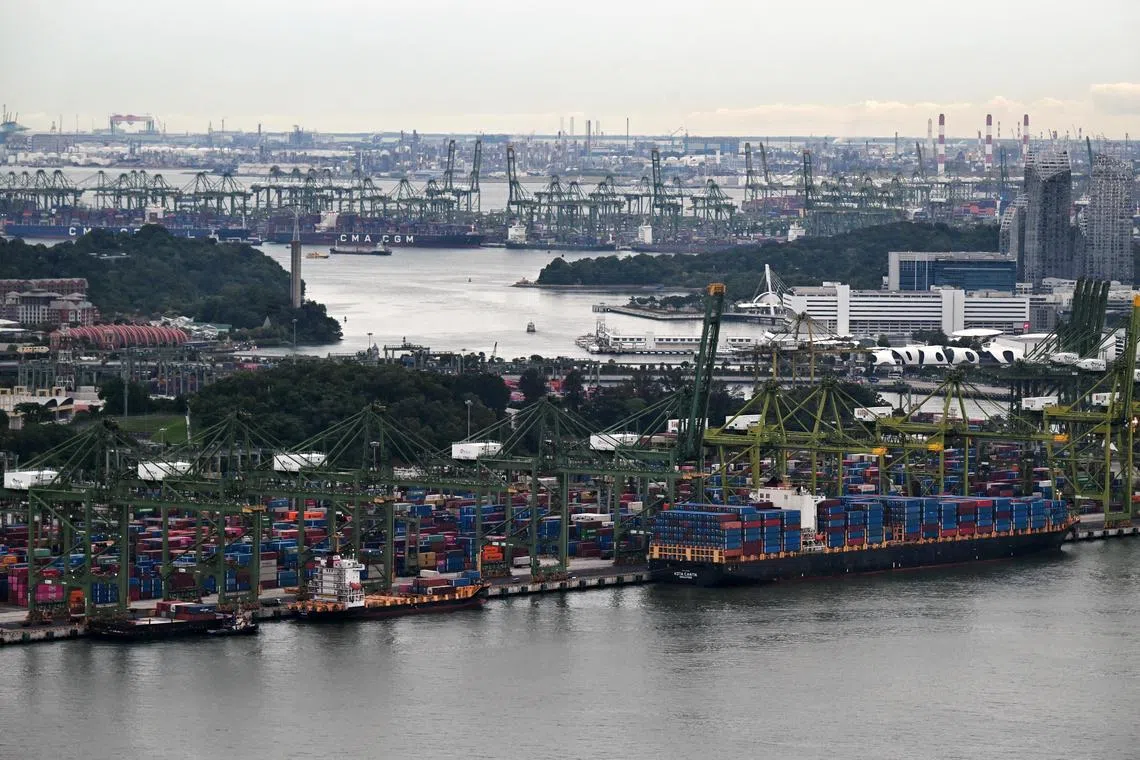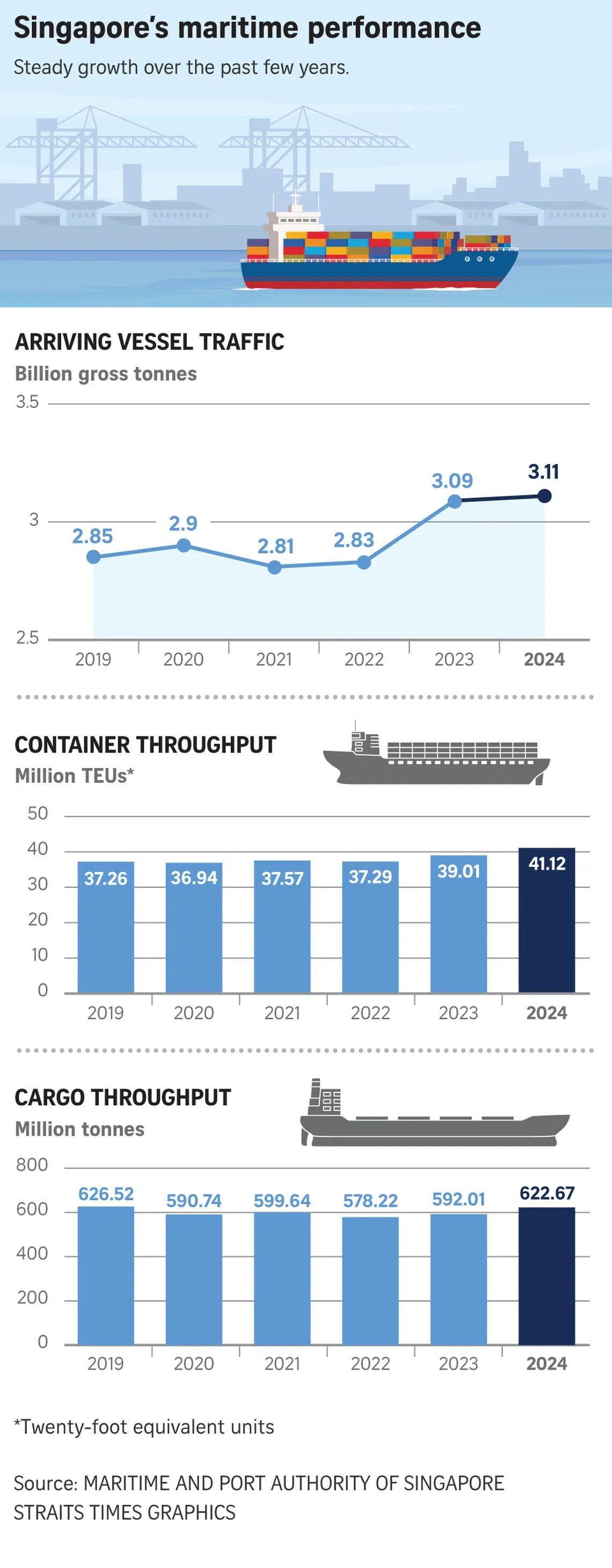Singapore’s port sets new records for vessel arrivals, shipping containers handled in 2024
Sign up now: Get ST's newsletters delivered to your inbox

In 2024, the port of Singapore handled an all-time high of 41.12 million shipping containers, or twenty-foot equivalent units.
PHOTO: ST FILE
Follow topic:
SINGAPORE – Singapore’s port registered a new record of 3.11 billion gross tons in arriving ship traffic in 2024, up from the previous high of 3.09 billion gross tons in 2023.
Annual vessel arrival tonnage – or the internal volume of all ships that arrive in a year, including their engine room and non-cargo spaces – is a common maritime industry measure of vessel traffic calling at a port.
In 2024, the port of Singapore also handled 41.12 million shipping containers, or twenty-foot equivalent units (TEUs) – an all-time high – said the Maritime and Port Authority of Singapore (MPA) on Jan 15. The 2024 record eclipsed the earlier record of 39.01 million TEUs in 2023.
MPA released these numbers at the Singapore Maritime Foundation (SMF) New Year Conversations, a yearly maritime industry event.
The world’s second-busiest container port after Shanghai, Singapore’s port also achieved new records in other categories, including the sale of bunker fuels and biofuel blends, as well as the total tonnage of Singapore-registered ships.
Meanwhile, MPA said reclamation works for the second phase of the Tuas mega port are about 75 per cent completed, with 11 of its berths now operational. Seven more berths will be up and running by 2027.
Tuas Port is being developed in four phases and will be the world’s largest fully automated port when completed in the 2040s.
By 2027, operations at Tanjong Pagar, Keppel and Brani terminals will be moved to the $20 billion mega port. Pasir Panjang Terminal will remain open until its operations are also consolidated in Tuas by the 2040s.
In 2024, Singapore’s port handled a total of 622.67 million tonnes of cargo, an improvement from 592.01 million tonnes in 2023. Nevertheless, the cargo that the terminals handled in 2024 still fell short of the pre-pandemic figure of 626.52 million tonnes in 2019.
Among the other new records set was the 54.92 million tonnes in total bunker sales registered in 2024 – a 6 per cent increase from 51.82 million tonnes in 2023. Bunkering is the process of supplying fuels to ships.
MPA attributed the increased uptake in part to extended shipping routes between Asia and Europe arising from the disruptions in the Red Sea, which is situated between Asia and Africa.
It said Singapore made “steady progress” as the world’s largest bunkering port, as it supplied over a sixth of total fuel used by global shipping in 2024.

Recounting the port congestion caused by the Red Sea crisis in mid-2024, the authority said it had worked with port operator PSA Singapore and unions to tackle the issue by commissioning new berths at Tuas Port, and reactivating berths and yard spaces at Keppel Terminal.
They also increased labour capacity, worked with shipping and feeder lines to optimise operational schedules, and allowed for the first time night-tow operations for container barges to and from Pasir Panjang Terminal. Feeder lines transfer goods from smaller ports to larger ones.
Vessels have been taking longer routes around South Africa to avoid attacks from Houthi rebels in the Red Sea since November 2023. As a result, ship timetables are being disrupted with missed sailing schedules and fewer port calls.
Another new record set by Singapore’s port in 2024 was the sale of alternative bunker fuels, which reached 1.34 million tonnes in 2024.
The sale of biofuel blends – which combine biofuel produced from biomass, such as agricultural biowaste, with conventional marine fuel – rose from 520,000 tonnes in 2023 to 880,000 tonnes in 2024, noted MPA.
The sale of liquefied natural gas here also increased from 110,000 tonnes in 2023 to 460,000 tonnes in 2024.
It added that 9.74 tonnes of ammonia were bunkered for the first time globally in trials at Singapore’s port, while 1,626 tonnes of methanol were made available commercially in Singapore.
For the first time, the total tonnage of Singapore-registered ships exceeded 100 million gross tons – clocking a new high of 108 million gross tons in 2024, up from 99.6 million gross tons in 2023.
Key maritime firms overseen by MPA spent a total of $5.2 billion in 2024, up from $4.8 billion in 2023.
More than 30 maritime companies – in areas such as shipping, insurance and marine technology – established or expanded their operations in Singapore in 2024.
Turning to developments on the sustainability front, MPA said the lead developer for a low- or zero-carbon ammonia power generation and refuelling solution on Jurong Island is expected to be announced in 2025.
Launched in December 2022, this project will facilitate ammonia bunkering at a capacity of at least 100,000 tonnes a year
MPA, together with trade agency Enterprise Singapore and other parties, also developed a technical reference – or guidelines – for electric harbour craft charging and battery swap systems in Singapore, which will be announced in the coming months.
In 2025, MPA anticipates steady growth for the Republic’s maritime sector, though the wider industry outlook for the year is likely to be shaped by geopolitical dynamics and shifting trade patterns.
It expects some re-routing of trade routes, and major shipping segments such as container ships and tankers to continue performing better than in pre-pandemic years.
Noting that regional supply chains are adapting to increasing demand and production in Asia, MPA said this has supported the growth of Asian ports.
The authority added that it will continue expanding capabilities in emerging areas such as space, aerial drones and cyberspace to support maritime businesses.
Speaking at the SMF event at Orchard Hotel on Jan 15, Minister of State for Transport and Law Murali Pillai said 430 maritime staff have completed training at the Maritime Energy Training Facility since it was set up in April 2024. The facility equips maritime workers with skills to handle clean marine fuels.
Mr Murali also said trials for the use of artificial intelligence in issuing insurance certificates for Singapore-registered ships recently started for a small group of shipping companies. The adoption of these tools will be expanded to the entire industry by the second half of 2025, he added.
At present, the process takes a few days for new submissions and 15 minutes for renewals. The new process will cut the process for both types of submissions to within three minutes.
On the outlook for Singapore’s maritime sector in 2025, Mr Murali expects some uncertainties given a more challenging global environment, such as evolving geopolitical dynamics amid continued tensions, the return of protectionist trade policies, shifting trade flows and rising competition with regional ports.
But he added that he is confident the sector will continue growing with strong support from the industry and unions, as well as partners from international organisations and governments.
Associate Professor Yap Wei Yim, head of the maritime management minor at the Singapore University of Social Sciences, foresees that escalating trade tensions between the US and China will generate uncertainty in global trade in 2025.
This may set the foundation for a challenging maritime environment with higher tariffs, which could dampen the demand for container shipping in Singapore.
Esther Loi is a journalist at The Straits Times, where she covers transport issues.

